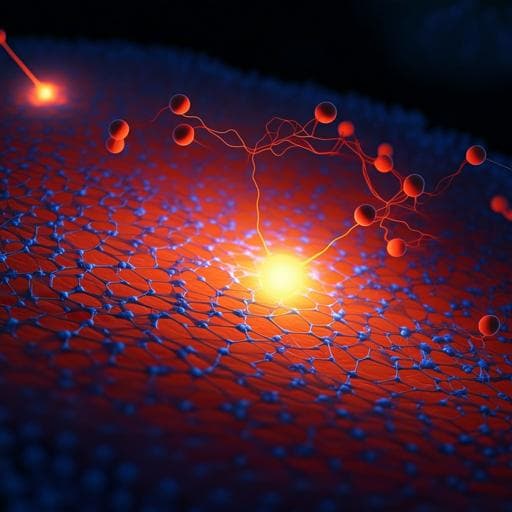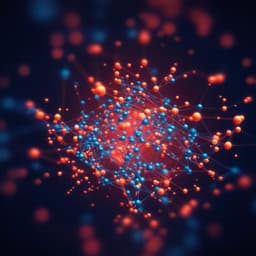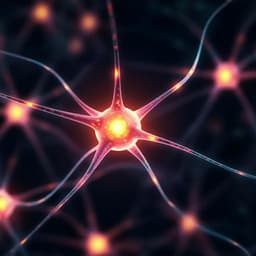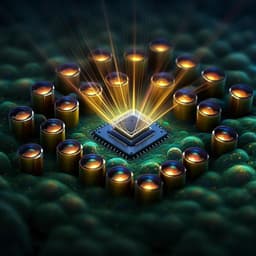
Physics
Mixed-state electron ptychography enables sub-angstrom resolution imaging with picometer precision at low dose
Z. Chen, M. Odstrcil, et al.
Discover how researchers Zhen Chen, Michal Odstrcil, Yi Jiang, Yimo Han, Ming-Hui Chiu, Lain-Jong Li, and David A. Muller have achieved groundbreaking low-dose, sub-angstrom resolution imaging with picometer precision. Their innovative mixed-state electron ptychography approach significantly enhances imaging efficiency while reducing radiation exposure, paving the way for new insights in the realm of complex nanostructured materials.
~3 min • Beginner • English
Introduction
The study addresses the challenge of achieving both atomic-scale resolution and picometer-level precision in imaging complex and radiation-sensitive materials (e.g., 2D materials, metal-organic frameworks, organic perovskites, and biological macromolecules). Conventional STEM techniques like ADF and coherent bright-field are dose-inefficient, using only a portion of scattered electrons and suffering from Poisson statistics where required dose scales with the inverse square of resolution. As a result, they often fail to provide sub-angstrom resolution or picometer precision at acceptable doses for weakly scattering or beam-sensitive samples. Electron ptychography utilizes full diffraction patterns and can recover the sample’s electrostatic potential with high dose efficiency, contrast, and resolution, potentially enabling extremely low-dose imaging. However, the intrinsic partial coherence of electron sources degrades performance if not properly modeled. Prior ptychography often assumed a single coherent probe mode, which is insufficient for sub-angstrom reconstructions with defocused probes and large fields of view. The research question is whether modeling the illumination as a mixed quantum state (multiple incoherent probe modes) enables sub-angstrom resolution and picometer-precision imaging at low dose and with large field of view using iterative electron ptychography.
Literature Review
Background literature identifies the limitations of conventional STEM ADF/cBF imaging in dose efficiency and precision for beam-sensitive materials. Electron ptychography, via Wigner-distribution deconvolution (WDD) or iterative algorithms, has demonstrated high dose efficiency, high resolution (even beyond lens limits), and high contrast. Partial coherence reduces image quality in STEM and affects ptychography signal-to-noise; WDD-based approaches can surpass temporal incoherent limits, but iterative methods can explicitly model partial coherence by decomposing the probe into a mixture of modes (mixed quantum state). Such mixed-state modeling has been successful in coherent diffractive imaging and X-ray ptychography. In electron ptychography, prior demonstrations typically assumed a pure coherent state or considered partial coherence only in proof-of-principle studies (e.g., Gaussian blind deconvolution or modal decomposition) that did not achieve sub-angstrom reconstructions. Simulations suggested low-dose feasibility, but experiments lagged due to practical issues (sample stability, beam stability, partial coherence). Recent low-dose, defocused, single-state ptychography achieved only >1 Å resolution without modeling partial coherence. This work builds on these findings by implementing mixed-state electron ptychography to overcome partial coherence limits and achieve sub-angstrom resolution at low dose over large fields of view.
Methodology
Experimental setup: Defocused-probe electron ptychography in a probe-aberration-corrected Thermo Scientific Titan Themis at 80 keV. Diffraction patterns recorded on an EMPAD (128×128 pixels, 0.86 ms readout, single-electron sensitivity, ~1/40 e− readout noise, 10^6:1 linear response). Illumination parameters: probe-forming semi-angle 21.4 mrad, defocus −55 nm, exposure 1 ms/frame. Beam current varied 0.09–14.3 pA (dose control via monochromator defocus); coherence change with current was small (<3%) and currents used were below source coherent current (~50 pA). Samples: monolayer WS₂ with bilayer WS₂/MoSe₂ islands; same crystalline orientation verified by ADF diffractogram.
Acquisition: Raster scan with defocused probe, providing a bright-field shadow image and high-angle dark-field speckle on EMPAD. Typical datasets: 256×256 diffraction patterns; subsets (e.g., 128×128) used for reconstruction. Field of view up to 30×30 nm^2 with scan step sizes typically 2.36 Å (also tested 0.85 Å up to 5.08 Å), enabling large FOV with fewer positions due to larger probe and overlap.
Ptychographic forward model and mixed-state probe: The exit wave under the generalized strong phase object approximation (multiplicative approximation): ψ_exit(r) = ψ_in(r−r₁) O(r), with O(r)=A(r)exp(iσV(r)). Partial coherence is modeled by decomposing the illumination into multiple mutually incoherent probe modes (eigenmodes of the density matrix). Diffraction is the incoherent sum of intensities from each mode. Typically 3–4 modes sufficed; more modes did not improve reconstructions.
Reconstruction algorithm: Generalized maximum-likelihood iterative ptychography with preconditioned gradient-descent optimization of the amplitude likelihood function, mini-batch optimization for convergence/noise robustness, and joint updates (probe/object, probe positions, wavefront variations). Illumination wavefront correction (efficient approximation to orthogonal probe relaxation) accounts for small probe variations. Probe position refinement: affine correction (scale, rotation, skew) followed by residual position error estimation; used to estimate and correct drift/scan distortions. Fourier Ring Correlation (FRC) used to estimate resolution from independently reconstructed phase images (1-bit threshold criterion) with image registration and edge apodization.
Key experimental parameters/examples:
- Large-FOV dataset: 128×128 positions, step 2.36 Å, reconstructed pixel size 0.2 Å (similar to ADF 0.19 Å).
- Low-dose series: doses 58,000; 3,300; 1,500; 790; 375 e Å^−2 (scan step 0.85 Å for ≥790 e Å^−2; 1.69 Å for 375 e Å^−2 via sub-sampling).
- High-speed example: 64×64 positions acquired in 7.6 s; comparable ADF with similar FOV and typical conditions would require ~36–144 s.
- Mixed-state reconstructions typically used 3–4 probe modes; comparisons made to single-state reconstructions.
Data processing: GPU-accelerated; reconstruction of the 30×30 nm^2 image completed in under one hour on a typical GPU. Processing time scales roughly linearly with number of diffraction patterns.
Key Findings
- Sub-angstrom resolution with large FOV at low dose: Mixed-state ptychographic reconstruction of WS₂/MoSe₂ (30×30 nm^2) achieved an isotropic information limit better than 1.4 Å^−1 with diffraction spots corresponding to 0.69 Å real-space spacing; real-space peak separations down to 0.6 Å observed. FRC indicated ~0.66 Å resolution. Dose for this dataset was 1.6×10^4 e Å^−2, substantially lower than typical ADF (∼10^5 e Å^−2) that gives only 1.5–2 Å resolution.
- Dose-resolution performance: Sub-angstrom resolution achieved at doses down to 4.0×10^3 e Å^−2. In a dose series on monolayer WS₂ using mixed-state reconstructions:
• 58,000 and 3,300 e Å^−2: W and S sublattices resolved; information transfer >1.1 Å^−1 (real-space <0.9 Å).
• 1,500 and 790 e Å^−2: both sublattices resolvable; information transfer >0.73 Å^−1 (real-space 1.37 Å).
• 375 e Å^−2: lattice recognizable; information transfer ~0.63 Å^−1 (real-space 1.59 Å).
- Mixed-state vs single-state: Mixed-state reconstructions provided higher resolution and contrast at the same dose and achieved comparable or better resolution at roughly half the dose relative to single-state reconstructions. Mixed-state also allowed larger scan steps (reduced overlap) with stable, artifact-free reconstructions (e.g., up to 72% overlap with 5.08 Å step using two modes vs ~95% overlap needed for single-state).
- Acquisition speed: With defocused probe and larger scan steps, ptychography achieved more than four-times faster acquisition for the same FOV compared with conventional ADF, while using ~10× lower dose.
- Precision of atomic position measurements: Using high-dose ptychography (1.25×10^5 e Å^−2), nearest-neighbor S–S and W–W distances exhibited standard deviations of 5.8 pm and 5.2 pm, respectively; residual probe position errors after refinement had st.d. ~0.16 Å and max ~0.6 Å. At low dose (~10^4 e Å^−2), ~10 pm precision for both W–W and S–S distances was achieved. Comparable ADF imaging (similar dose) yielded W–W precision of 13.6 pm, and S atoms were not visible at low collection angle settings typically used for ADF.
- Detector and sparsity: EMPAD’s negligible read noise and single-electron sensitivity were critical. Even at doses where average dark-field pixels had fewer than one electron and ~500 electrons per position (e.g., 790 e Å^−2), averaged diffraction patterns retained sharp disk edges and allowed phase retrieval.
- Dose-efficiency summary: For a given information limit, mixed-state ptychography required 10–50× lower dose than ADF. At higher doses, ptychography’s resolution was limited by detector scattering angle cut-off, surpassing ADF’s probe aperture-limited resolution.
Discussion
Accounting for partial coherence via mixed-state modeling is essential to achieve simultaneous sub-angstrom resolution, high contrast, high precision, large FOV, and low-dose imaging in practical electron microscopes. The mixed-state approach captures decoherence-like effects (finite source size, chromatic aberration, sample vibration, instrumental instabilities), improving reconstruction quality and relaxing scan overlap requirements, which enables faster acquisitions and larger FOVs. The approach leverages defocused probes and full-field diffraction data to decouple real-space sampling from scan step size. The results show superior dose efficiency compared to ADF and improved robustness over single-state ptychography, making atomic-resolution imaging feasible at doses compatible with beam-sensitive materials.
Limitations and model validity: The generalized strong phase approximation assumes thin samples with minimal propagation effects and weak amplitude damping. Significant deviations (e.g., amplitude deviating >10% from unity or phase-amplitude mixing) signal breakdown. For typical parameters (e.g., 300 keV, θ_max ~20 mrad), the thickness limit due to propagation is ~6.4 nm; heavy elements and multiple scattering may impose stricter limits, warranting multi-slice ptychography or scattering-matrix approaches. Detector pixel size can reduce speckle contrast for large probes, limiting maximum practical probe size.
Future directions: Improved source coherence (e.g., cold FEG), larger/faster detectors, multiple scans with shared object information, and probe relaxation can further increase scan step sizes and FOV, reduce dose, and mitigate long-term instabilities. GPU acceleration enables timely reconstructions; fewer scan positions with defocused probes reduce computational load. Applications include in situ phase-contrast STEM of dynamic processes, ptychographic tomography, and low-dose imaging of light elements and biological specimens; mixed-state frameworks could also enable retrieval of mixed quantum states in samples.
Conclusion
Mixed-state electron ptychography delivers sub-angstrom resolution (down to ~0.66–0.69 Å) and picometer precision (≈5–10 pm) at doses one to two orders of magnitude lower than conventional ADF, while enabling larger fields of view and faster acquisitions by using defocused probes and relaxed scan overlap. Modeling partial coherence via probe mode mixtures is key to achieving high-resolution, high-contrast reconstructions under realistic instrument conditions and at low dose. The method outperforms single-state ptychography in both resolution and dose efficiency. Future work should extend mixed-state ptychography to thicker samples via multi-slice models, improve detector capabilities and source coherence to further increase FOV and speed, and leverage multiple-scan strategies and advanced reconstruction algorithms for even lower dose and higher robustness. The approach opens opportunities for quantitative, low-dose imaging of beam-sensitive materials and biological specimens, in situ studies, and ptychographic tomography.
Limitations
- Validity limited to relatively thin samples where the generalized strong phase object approximation holds; significant probe evolution and multiple scattering (especially in high-Z materials) can invalidate the model, necessitating multi-slice or scattering-matrix approaches.
- Potential phase–amplitude mixing and amplitude deviations (>10%) indicate model breakdown.
- Detector pixel size can reduce speckle contrast for large probes, limiting maximum practical probe size.
- Data processing time, while GPU-accelerated, still scales with number of diffraction patterns.
- Reconstruction quality depends on stability (sample drift, beam/optical instabilities), though mixed-state modeling and position refinement mitigate these effects.
- Present demonstrations are on 2D/ultrathin materials; generalizability to thicker, strongly scattering specimens requires further methodological advances.
Related Publications
Explore these studies to deepen your understanding of the subject.







